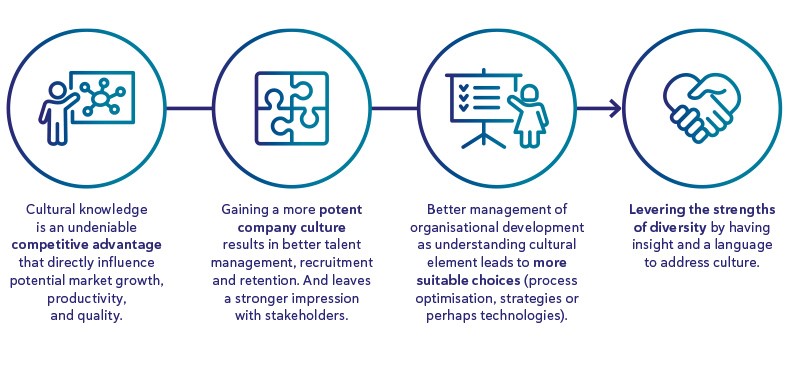Can organisational culture be changed?
02 Avril 2019
Article written by Anna Balk-Møller
02 Avril 2019
Article written by Anna Balk-Møller
Culture is said to be very difficult to change. Because it is. It’s not that cultures are set in stone or don’t transform over time, but making deliberate efforts to adapt an organisational culture is a comprehensive task that require three things:
The first obstacle for changing a culture is comprehending it. We often talk about our culture being this or the other way. But it is typically based on sporadic observations without a deeper understanding of what fuels it.
Culture consists of A) behaviour and artefacts, B) core values and strategies (we are conscious about both A and B) shaped by C) an unconscious system of entangled aspects such as, unspoken norms, processes, market position, history, products, language, management style, etc. Claiming that we are conscious about our culture might be a stretch, as we often become conscious about it when we cross path with someone displaying a different demeanour. This is when we are reminded not everyone does things the same way as we do. So, we often talk about our culture, but we seldom understand what it really means.
Insights about our organisational culture have several benefits:

Though it’s not difficult to see how understanding our culture provides value, the questions remains: how we gain the systematic knowledge about something which to a large extent happens unconsciously? How we then make the change we desire?
There are different tools available for mapping organisational culture. Denison’s culture model measures the culture’s impact on performance and effectiveness. Intercultural DISCTM explains why people behave as they do and how to maximise efficiency between different styles. GlobeSmart focus on strengthening the global team and global leadership competencies, and proCulture© maps cultural traits which can then be used to plan for a successful integration, to compare cultural traits to strategic goals, as a dialogue tool for collaboration, or as a foundation for Change Management strategies.
What they all have in common is that they provide a starting point for conceptualising culture and thereby make it operational. An element we can understand, measure and track. Is any of them a perfect capture of culture? No – the more you know about the field of culture, the more you realise how multifaceted it is. But, conceptualising our culture will still get us closer to the benefits.
3 pitfalls to avoid when mapping culture:
Once mapped, the deliberate alternation of cultural aspects can begin. Behavioural psychology has revealed that although we think our actions derive from our values, the truth is reversed – our norms are subsequent rationalisations of our preferred behaviour. This means that we cannot decorate the reception with our ‘Guiding Principles’ on wall stickers and trust that our employees then comply. The risk of this cultural strategy is that we either have strategic buzz-words with limited resonance or we have decorative catchphrases that de facto is beyond our control.
As an example, let’s say that one of our core values is ‘Collaboration’. When measuring our culture, we might find that people are somewhat more individualised than we aspire to be. People are very mindful of others and always happy to help a colleague (this is the behaviour we knew, and that made us confident when we wrote ‘collaboration’ on the reception wall). But looking across the cultural parameters, we also find that recognition is solely given at individual basis, that people are allocated to tasks primarily based on their competencies with little regard to network, and that managers seldom seek input from employees before making decisions. With this information, we know which buttons to turn if we want to be more collaborative. By making the abstraction (collaboration) tangible, we can succeed in changing our culture in the direction we want.
In conclusion it is worth repeating the prerequisites for changing culture: